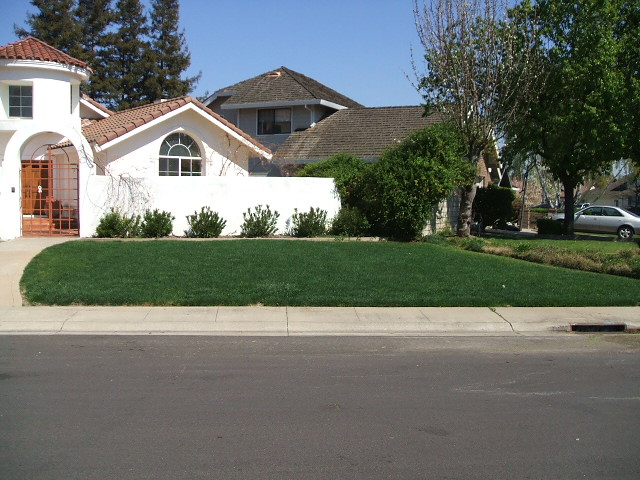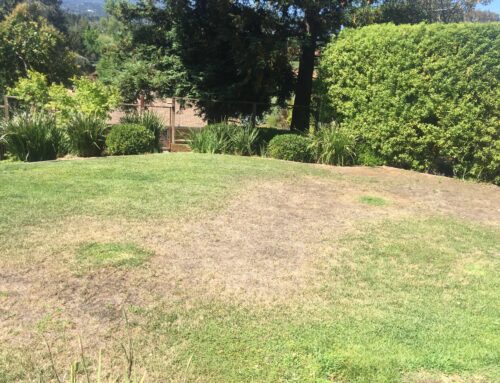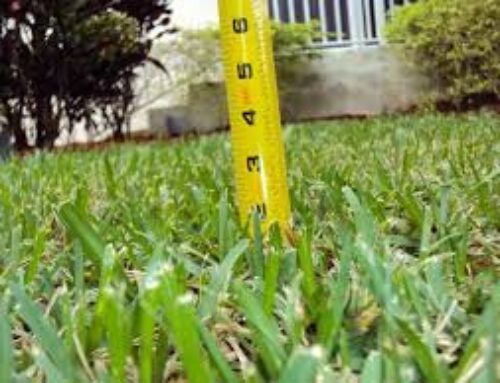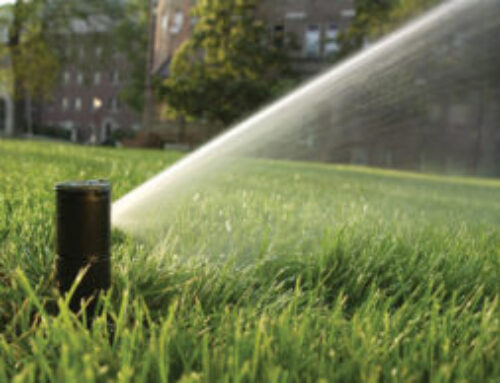Why is it that having a nice lawn seems difficult for so many people? Why are some lawns green and lush, while others slowly turn to dust?
Actually, there are only seven possible reasons why a sad lawn isn’t nicer. You need a list of these seven rules so you can make sure you are following the rules.
The rules are surprisingly simple:
Rule #1: “Start with real grass, not weeds”
If there are too many annuals (plants that die yearly) or seasonal weeds, it’s not a real grass lawn. That’s why it’s important to start with at least 60% of desirable, perennial grasses (those that stay green all year long). Watering weeds that die yearly or grass that is seasonal will not make for a nice lawn.
The annual shown above is poa annua (annual bluegrass). It dies in summer and returns in fall from seeds. Watering winter annual grasses (such as poa annua) will not keep them alive in summer.
If necessary, renovate (dethatch, aerate and reseed) or re-sod. If you are not sure whether your lawn is “desirable,” send some images of your lawns using this link: Send pictures of your lawn to Fairway. We’ll call you with free advice as soon as we have seen your images. If your lawn is not at least 60% desirable grasses, we won’t aerate it because aerating is not the correct thing to do.
To learn how to control annuals and all other weeds growing in your lawn, visit the Lawn Weed ID Page. There, you’ll see photos of weeds so you can identify which weed you have. In addition, you’ll find information about how to control each weed. You can buy “selective” weed killers that don’t harm the grass, and you don’t have to spray the weeds individually. You simply spray the area of lawn that has weeds; they all die and the grass remains. Controlling weeds is easy and can be done by the homeowner whenever needed at a fraction of the cost of a pest control visit.
If necessary, renovate (dethatch, aerate and reseed) or re-sod. If you are not sure whether your lawn is “desirable,” send some images of your lawns using this link: Send pictures of your lawn to Fairway
Rule #2: Grass Won’t Grow on a Brick
Remember the Adobe Indians? They fashioned bricks from clay and built houses using the bricks. Since clay soil is very dense and compacts easily, the sun-hardened bricks became nearly waterproof. This was good for the Indians, but it’s bad for your lawn. Our soil is mostly clay and tends to compact, limiting water and root penetration. The only way to relieve compaction is by aerating. For more information about aerating and how is saves water, call Fairway Lawn Service 1-800-497-4075 or request a FREE Quote.
Learn what to do with the cores left from the aerating machine.
Rule #3: “Limit Shade”
Grass doesn’t grow well in shade. No matter what you do, grass in the deep shade gets thinner and thinner. Replacing the sod simply puts off the inevitable thinning.
Lawns need at least 2-3 hours of direct sunlight daily. So if you have lawn areas that get less sun, either trim out some tree branches, move the garage to the left, or consider an alternative to grass in those shady areas.
Rule #4: “Water!”
Water is essential for lawn maintenance. Whenever there is less than 1″ of water in a week (from rain), additional water is needed to sustain proper plant life. The capacity of the soil to store water for plant use depends on two factors: permeability and retention. If the water runs off and does not penetrate, retention cannot occur. Likewise, if the water penetrates but runs through the soil, it will not be there when the plants need it.
Clay soils retain water well but have penetration problems, mostly because of compaction. Once the compaction is alleviated, the penetration factor goes up and the lawn is able to hold more water.
To determine how many minutes to water to get the required 1″ of water every week, do this test: Using a bunch of empty yogurt containers or coffee cups, distribute the cups all over the lawn, then water for a set amount of time, such as 15 minutes. Measure the amount of water in the driest cups, ignoring the cups that seem to have twice or three times the amount of water in them. If 15 minutes got you an average of 1/2″ water in the driest cups, then 30 minutes would equal 1″ of water. Do this test for each station or valve, then set the timer accordingly.
http://fairwaylawnservice.com/how-to-water-your-lawn-properly
Rule #5: Feed Me!
Unlike humans, lawn plants don’t grow old; they can grow new blades and new roots. But, if the rate of decline is greater than the rate of regrowth, the lawn goes downhill (if you’ll pardon the pun). If you only ate once a week, you’d be hungry all the time. Your lawn is no different.
If you fertilize every six to eight weeks year round, your lawn will always be making new blades and roots, and the regrowth will be greater than the rate of decline, and your lawn will improve.
To feed your lawn, Fairway recommends using the same fertilizer we use, which is not available at your local big box store. You can get the right fertilizer at Site One Landscape Supply. It’s not as convenient as your local big box store, but Site One has the fertilizer you need. And, if you use Fairway’s Customer Number 1113909 at Site One Landscaping Supply, you’ll get over 30% off! Click HERE to read the technical specifications sheet.
 This is the same fertilizer that golf courses use!
This is the same fertilizer that golf courses use!
- In winter, we use 21-7-14 (Best Turf Royale)
- In summer, we use 16-6-8. (Best Turf Supreme)
Wait 6 weeks from when we fertilized, then apply 5-7 lbs fertilizer per 1000 square feet of lawn area. If you aren’t sure of your lawn size (square feet), please call us at 800 -497-4075 and we’ll look it up in our database.
Do NOT cast the fertilizer by hand; it won’t be even! Use a whirlybird type spreader to apply the fertilizer evenly. If you aren’t sure how big your lawns are, call us; we know!
For more technical information about fertilizers, visit this link: The Science Behind Fertilizer.
Rule #6: “Never Cut it Short”
If your lawn is being cut any shorter than 2 1/2″ or if mowing removes more than 1/3 of the grass blades, you’re asking for trouble! Just look at the list of problems that mowing short causes:
a. shallow roots (roots die back and re-grow annually; shallow roots are a response to the shorter cut)
b. thatch buildup (another response to cutting too short)
c. weeds (weed seeds need the sun to germinate; cutting short exposes the seeds to the sun)
d. crabgrass (same seed issue as above)
e. Bermuda grass (Bermuda grass tolerates short cuts – fescue and bluegrass do not)
f. wasted water (requires up to 30% more water to keep the lawn green)
Lawns that are mown at 3″ (after mowing) retain more water in their blades, have deeper roots, and provide shade for the soil, preventing evaporation. You’ll have a much nicer lawn and you’ll use much less water when you mow long. Mow as often as needed, so you aren’t cutting off more than 1/3 of the blade. For more information about http://fairwaylawnservice.com/how-to-mow-your-lawn-properly/
Rule #7: “Watch for Damage”
If you see brown areas forming in your lawn, immediately check your sprinklers for adequate coverage. There may be a blocked or broken head.
If there seems to be enough water, pull on the grass to see if it pulls out easily. If it does, you’ve got grubs like the the picture on the right above. If the grubs are active (spots are getting worse), use an insecticide such as Bayer Advanced Grub Control. The two pictures on the right show new grub damage and old grub damage.
If the grass seems well-rooted, the brown grass may be an annual or have gone dormant, like the grasses in the hills do as soon as it gets warm. This seasonal browning of annual grasses occur as soon as the grasses in the hills turned brown. There aren’t any annuals that turn brown in the middle of summer.
Questions about your lawns? Request a Free Quote!
Call Fairway at 1-800-497-4075 or Contact Us for free advice.Attach an image of your issue and we will be happy to help!We'll give you free expert advice about your lawns, whether you're a customer or not.
Call Fairway Lawn Service to have your lawns aerated, have Moisture Manager appliedto your lawn or yard or request a FREE QUOTE.






